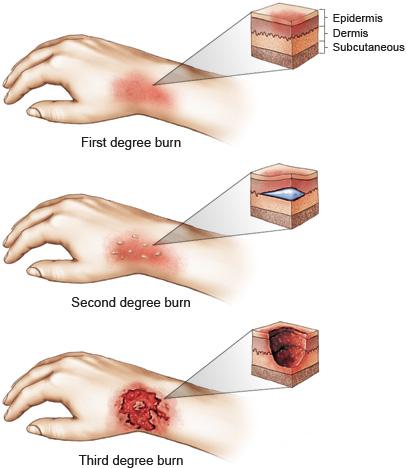
FOURTH DEGREE BURNS
HELPING BURN SURVIVORS AND THEIR FAMILIES SHARE, CARE AND CARRY ON.
Call us at: 844.669.7007
 Fourth degree burn are the most serious burns that can be experienced. To understand fourth degree burns, some understanding of the structure and function of skin is needed.
Fourth degree burn are the most serious burns that can be experienced. To understand fourth degree burns, some understanding of the structure and function of skin is needed.
The Structure of the Skin
Your skin is your largest organ. Its function is to provide a protective barrier against the environment. Your skin protects you against infection. It also helps you to regulate your body temperature. Your skin also gathers sensory information, which helps you to differentiate many sensations such as pain, temperature, and pressure.
Your skin is composed of three layers. The epidermis is the outermost layer. It is very thin over your eyelids and is thickest on the palms of your hands. Specialized cells in the epidermis perform unique functions. For example, melanocytes produce pigment that gives your skin its color.
Under the epidermis is the dermis, the middle layer of your skin. The dermis is composed of three types of tissue, collagen, elastic tissue and reticular fibres. These tissues are not arranged in layers, but are present in all layers of the skin. The dermis is home to many specialized cells and structures. Hair follicles, oil glands and sweat glands are all found in the dermis, as are numerous blood vessels and nerves which transmit the sensations of pressure and touch.
The innermost layer of skin, lying under the epidermis, is called the subcutaneous layer or hypodermis. Subcutaneous tissue contains a layer of fat and connective tissue. In this layer are also large blood vessels and nerves. This layer varies in size from person to person. The subcutaneous layer controls both the temperature of the skin itself and the body’s temperature.
Types of Burns
First degree burns (superficial burns) affect only the epidermis, causing redness and discomfort. First degree burns are rarely serious and heal by themselves within days. First degree burns can occur as a result of exposure to the sun (sunburn) or exposure to hot liquids.
Second degree burns (partial thickness burns) affect both the epidermis and portions of the dermis. These types of burns cause blistering. These burns require longer periods of time to heal and may result in permanent scarring. They may sometimes require skin grafting if they extend deep into the dermis. Second degree burns can result from exposure to hot or scalding fluids or from flash and flame injuries.
Third degree burns (full thickness burns) affect all layers of the skin. These burns are severe and always require skin grafting as they result in the destruction of skin cells. These burns may result from prolonged exposure to flame, chemicals, electricity, scalding liquids or steam.
Fourth degree burns (full thickness burns) affect all layers of the skin and also structures below the skin, such as tendons, bone, ligaments and muscles. These burns are not painful, owing to destruction of nerve endings. They may occur from prolonged exposure to flame or electrical injury. These burns always require surgery or grafting to close the wounds. Fourth degree burns often result in permanent disability and may require lengthy rehabilitation. Fourth degree burns can be life-threatening and may require amputation due to the severe nature of fourth degree burn injuries.
An understanding of the structure of the skin is necessary to understand how burn injuries are classified. The skin is divided into three layers, the epidermis, the dermis and the hypodermis (subcutaneous) layers. Burns are classified as to the extent that they affect the layers of skin. Fourth degree burn affect all three layers of skin and structures below the skin, such as bone and muscle. Fourth degree burns can be life-threatening and survivors are often left with serious disability and disfigurement.

